10 strangest deep sea monsters in the world
In the deep water areas of the world's oceans, many species of animals appear that are extremely strange to humans.
1. Japanese Spider Crab
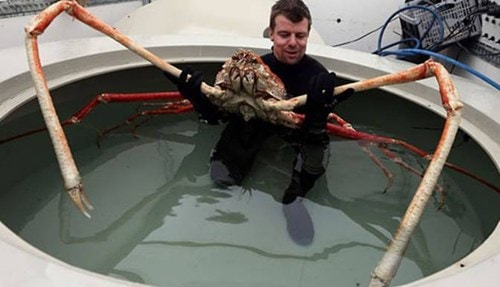 |
Japanese spider crabs, scientifically known as Macrocheira kaempferi, live at the bottom of the Pacific Ocean from 50 - 600m.
2. Physalia physalis
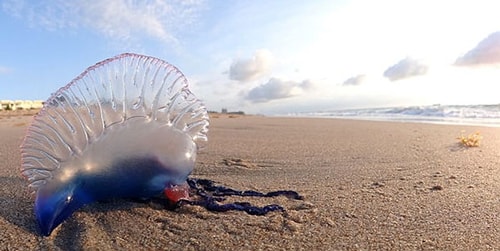 |
This jellyfish-like creature can be found in the tropical and subtropical regions of the Pacific, Indian, and Atlantic Oceans. Physalia physalis has a powerful venom contained in its tentacles. Despite its transparent appearance, it is not a jellyfish, but a colony of many individuals, however, each individual in the colony cannot survive independently. With its rather terrifying appearance, Physalia physalis reminds people of an alien or a sea monster.
It is the largest crab species currently living on Earth with the largest leg length of any crustacean, which can reach up to 3.7m from claw to claw. The body length can reach up to 40cm and the weight can be as much as 19kg in males, while females have shorter claws.
In 2009, a 40-year-old giant spider crab named Kong was caught in Suraga Bay (Japan). It weighed 15 kg, was 3 m long and had not stopped growing yet. It was estimated that it could be as long as a car.
3. Atlantic wolffish
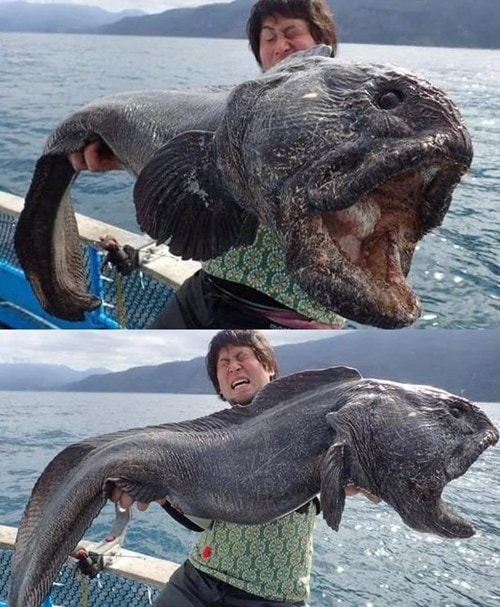 |
Atlantic wolffish are found at depths of up to 600m in the waters off Cape Cod and the Mediterranean. They use their powerful jaws to feed on shellfish, crustaceans, and echinoderms, and do not eat other fish. The largest wolffish have been recorded at 150cm in length and 18kg in weight. They vary in colour from purple-brown to olive green or blue-grey.
4. Fangtooth fish
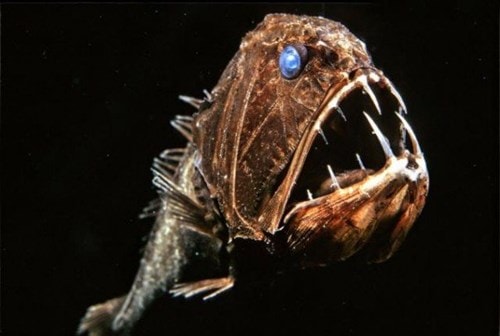 |
Fangtooth fish, scientifically known as Anoplogaster, lives at a depth of 487.68m with a short body length of about 15.24 cm. However, they have a large head, a wide mouth and long, sharp fangs, giving them the nickname "goblin fish". Fangtooth fish are considered a formidable "character" in the marine world. This fish is quite "easy to raise", they eat anything they can find. They are often found in temperate or tropical seas.
5. Regalecidae Moon Sailfish
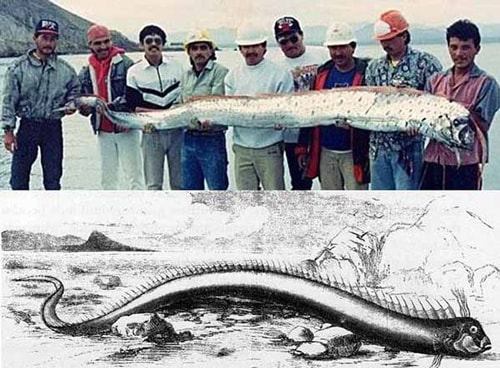 |
Regalecidae or moon sailfish is a flatfish, some can reach up to 11 m in length. It is the longest bony fish in the world and is usually found at depths of nearly 1 km. Regalecidae are very rare, and people usually only find their bodies washed ashore after big storms. Therefore, they have become the subject of many legends about dragons. Regalecidae live deep in the sea, and only come to the surface when they are very weak or about to die.
6. Frilled shark
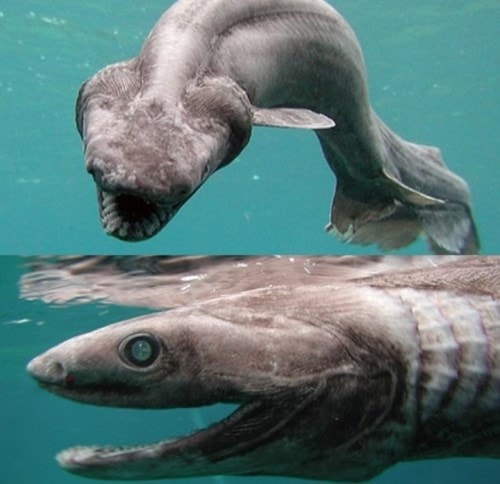 |
This is a fish species that lives mainly in deep sea areas (over 1,500m), distributed in the seas of the Atlantic and Pacific Oceans.
This fish has some characteristics of "primitive" sharks, considered "living fossils" on the seabed of the dinosaur era and considered one of the oldest sharks (96 million years ago). They can reach 2m in length, with a dark brown body like an eel. They are one of the rare fish species with up to 6 pairs of gill slits similar to prehistoric sharks. When moving and hunting, the lizard shark flexes its body to move forward flexibly like a giant sea snake.
7. Goblin Shark
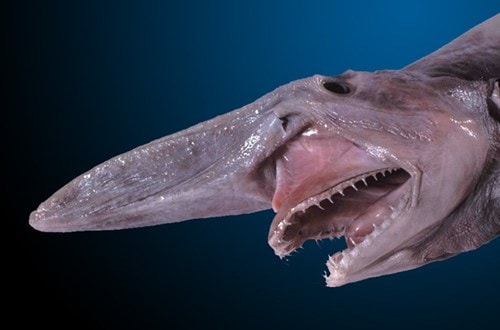 |
They have the scientific name Mitsukurina Owstoni, a deep-sea shark (about 200m) in many seas from the Pacific Ocean, Atlantic Ocean, Gulf of Mexico, most commonly in Japan. They have an ugly body with a long hooked nose like a bird's beak, horns longer than the snout like a trowel. They are the only shark species that is pink. Adult males are usually 2.4 - 3.1m long and females are 3.1 - 3.5m. The largest specimen found was up to 3.9m long and weighed 210kg.
8. Humpback Anglerfish
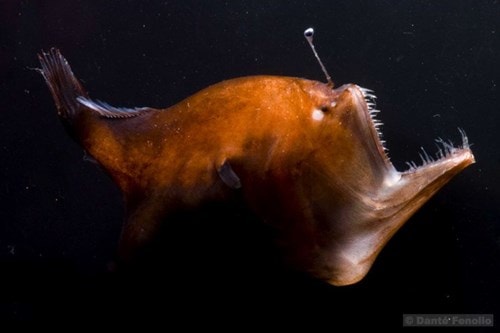 |
Their scientific name is Melanocetus johnsonii, living at a depth of 2,000m. Anglerfish have a bulky, strange appearance, a round body like a ball and about 12.7cm long.
This species has a wide, gaping mouth with rows of sharp teeth, earning it the nickname "ugly black devil". Along the back of the anglerfish are densely covered with luminous spines to attract prey. When the prey comes close enough, they immediately grab and crush it with their large, powerful jaws.
9. Devil Squid
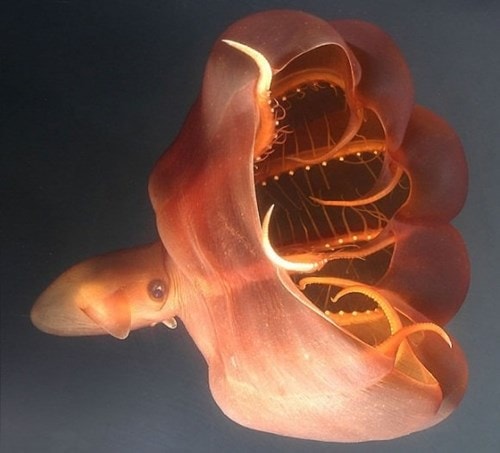 |
Demon squid (scientific name Vampyroteuthis) live at depths of 600–900m or lower. They do not have an ink sac, their bodies have two large edges, and their bodies are smooth and soft, making them easily mistaken for jellyfish.
Although only 15 cm long and not dangerous to humans, the demon squid looks very fierce with spherical eyes as big as a large dog's. The tentacles are covered with spikes that look like sharp teeth, giving them the nickname "demon squid". The bioluminescent parts are evenly distributed throughout the body and can be turned on or off at the will of the demon squid. The demon squid can swim at extremely fast speeds, an advantage of the demon squid when hunting prey and running away from enemies.
10. Pacific Snakefish
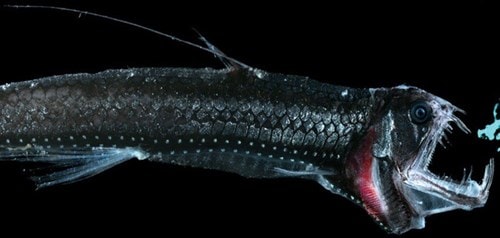 |
They have the scientific name Chauliodus macouni, a predatory fish that lives at depths of 200–5000m below the ocean surface.
The Pacific snakehead is characterized by its large mouth, long fang-like teeth, and long dorsal fin rays (half its body length).
They feed mainly on crustaceans and small fish and have a body length of about 30cm. It is believed that the first dorsal fin glows to attract prey.
According to Family & Society


